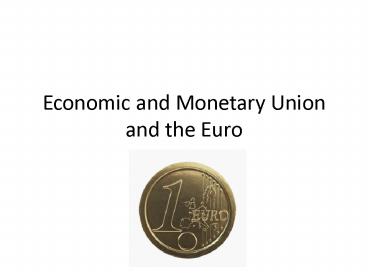Economic and Monetary Union and the Euro - PowerPoint PPT Presentation
1 / 26
Title:
Economic and Monetary Union and the Euro
Description:
Economic and Monetary Union and the Euro From the Treaty to application The Treaty of Maastricht (1992) enshrined the principle of a single European currency On 1 ... – PowerPoint PPT presentation
Number of Views:397
Avg rating:3.0/5.0
Title: Economic and Monetary Union and the Euro
1
Economic and Monetary Union and the Euro
2
From the Treaty to application
- The Treaty of Maastricht (1992) enshrined the
principle of a single European currency - On 1 January 2002 the euro started circulating in
12 European countries
3
The origin
- In 1970 the Werner Report proposed a convergence
of economies and currencies of the six EEC
countries - In 1979 the European Monetary System (EMS) was
set up - In 1986 the Single European Act implied the
convergence of European economies
4
Economic and Monetary Union
- In 1989 Commission President Jacques Delors put
forward a plan and timetable for bringing about
economic and monetary union (EMU) - The Treaty of Maastricht laid down a set of
criteria to be met by member states if they were
to qualify for the EMU
5
Criteria
- Curbing inflation
- Cutting interest rates
- Reducing budget deficits toa maximum of 3 of GDP
- Limiting public borrowing
- Stabilising the currencys exchange rate
6
Opting out
- Denmark and the UK reserved the right not to move
to the third stage of EMU (adoption of the euro)
7
European Central Bank
- In order to ensure the stability of the euro, an
independent European Central Bank (ECB) was set
up, based in Frankfurt, and given the task of
setting interest rates to maintain the value of
the euro
8
Economic union
- The euro has replaced currencies that were
traditional symbols and instruments of national
sovereignty (f. e. German mark) - It moved Europe considerably closer to economic
union - The need for monetary stability
9
Stability pact and economic growth
- In Amsterdam, in June 1997 the European Council
adopted two important resolutions - 1. Stability and growth pact (maintaining
budgetary discipline) - 2. Economic growth (employment as priority)
10
Coordinating economic policies
- In Luxembourg, in December 1997, the European
Council adopted a resolution on coordinating
economic policies to establish stronger ties
between countries that adopted the euro
11
Stability of the euro
- In spite of turbulent world situations and
crises, the euro has enjoyed that kind of
stability and predictability that investors and
consumers need
12
The worlds second most important currency
- The first one is US dollar
- The euro is increasingly being used fort
international payments and as a reserve currency
13
Benefits of a single currency
- The euro has given European citizens a much
clearer sense of sharing a common European
identity (free movement of people, goods and
capital)
14
Someting about the euro
15
The name
- The name euro was adopted on December 16, 1995
16
Euro banknote designs
- a design competition ? winning design by Robert
Kalina ? theme Ages and styles of Europe - Classical for the 5
- Romanesque for the 10
- Gothic for the 20
17
- Renaissance for the 50
- Baroque and rococo for the 100
- Iron and glass architecture for the 200
- Modern 20th century architecture for the 500
18
Euro coin designs
- a design competition ? winning design by Luc
Luycx - Avers of all euro coins are same, but revers are
different for each European Union Member Stete - Italy
19
- The design of euro coins differs in
- Common side
- Colour
- Edge
- Diameter and thickness
- Mass in grams
20
Banknote security features
- The raised print
- The watermark
- The security thread
- The see-through register
21
- F oil stripe/foil patch
- Iridescent stripe/colour- shifting ink
- Micro lettering
- Ultra-violet properties
- Infra-red properties
22
The euro today
- Read and discuss the text The failure of the
euro (handout)
23
Vocabulary
- Inevitable neizbježan
- Adverse- negativan
- To plague muciti, ometati, stvarati teškoce
- Austerity measures mjere štednje
- To clash sukobiti se, ne slagati se
- Impetus- poriv, pobuda, poticaj
- To instill usaditi, uliti, ulijevati
- The Common Market tržište EU (zajednicko
tržište)
24
The History of the Euro
- http//www.youtube.com/watch?vPdLr3lTSyns
- What was contemplated by the League of Nations in
1929? - What does ECU stand for?
- Which countries opted out?
- Did the euro help tourism?
25
Countries that use the euro
- The following members of the European Union use
the euro - Austria, Belgium, Cyprus, Estonia, Finland,
France, Germany, Greece, Ireland, Italy, Latvia,
Luxembourg, Malta, The Netherlands, Portugal,
Slovenia, Slovakia, Spain - The following members of the European Union do
not use the euro - Bulgaria, Czech Republic, Denmark, Croatia,
Lithuania, Hungary, Poland, Romania, Sweden and
the United Kingdom.
26
Thank you for your attention!

